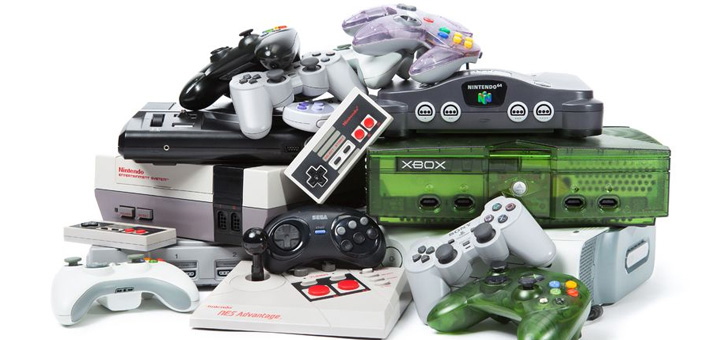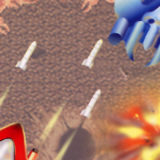If you’ve been playing games for a long time, you’ve probably amassed a bunch of games and related paraphernalia. Does this sound like you? If so, you are already on the way to being a collector!
It can be quite confronting to start taking your collection more seriously though. Where do you start looking? How much money should you be spending? What’s sort of games should you be searching for? It is easy to throw away money if you don’t plan ahead and do a little bit of research first.
So before you jump online and spend your life savings on creating the ultimate cave of retro gaming wonders, read this guide. It will help point you in the right direction, as well as provide some handy links to get you started.
Note: This is a retro game collecting guide intended for beginners. However, there may also be a few new ideas and links in here for those who have already started their collection – so read on!
Why should I start collecting retro games?
There are lots of reasons to start collecting retro games, but some are better than others. If you enjoy playing games in your downtime, have younger family members who you enjoy sharing games with or if you love searching through electronics stalls at markets then you are probably heading down the right path by starting a collection.
If you are planning on actually making money from your collection over time, you are likely to be disappointed. Whilst certain games and hardware can become more valuable over time, you are going to struggle to turn enough profit to justify the time and effort you spent finding them in the first place. Additionally, potential buyers can dry up when games are re-released, either digitally or through reproductions.
What I’m saying is that you really need to be in it for the love of games.
What sort of collector are you?
It is extremely important to decide on a focus for your collection when you are first starting out. This will help you to narrow down the sorts of things you are looking for, as well as stop you from spending too much money along the way. Don’t worry – you can always expand the nature of your collection later!
Some great ways to theme your collection are:
- By system. For example: if you grew up owning a Sega Master System, you may want to start by tracking down games specifically for that console.
- By genre. For example: if you love fighting games, you could see how many weird and wacky titles you could find across the generations to go with the classics.
- By franchise. For example: if you are the world’s biggest Spyro fan, you could try and find all of the different Spyro games across home consoles and handhelds.
You don’t need to stick to this forever – remember, this is a beginner’s guide after all! Narrowing your focus when you are starting out will simply help to keep you on track and let you learn how to develop a strategy for finding the right games at the right price. Once you are more comfortable, then you can explore some of the more complicated aspects of collecting (such as searching for prototypes).
What do I need to research?
Once you have nailed down a theme, you need to start researching what you should be looking for and how much you should expect it to cost.
Remember, not every game you are looking for will be expensive. In fact, the vast majority of them will probably be dirt cheap! That’s one of the benefits of collecting retro games.
It’s good practice not to take the seller’s word that a game is ‘super-rare’ or that they are offering it at ‘a great price’. You need to do your own independent research and stick to your budget. This goes double if the price is high simply because it is sold as being in ‘mint condition’, since a game having a box and manual doesn’t necessarily increase its market value as much as you might expect. This is all obviously dependant on the game or hardware in question, but it pays to be on the wary side.
An excellent site to bookmark is Price Charting. This is an extremely handy resource to have on hand that lets you search for the current market prices of individual retro games and hardware. You can see price breakdowns for ‘Loose’, ‘CIB (Complete In Box)’ and ‘New’. This really helps when trying to decide whether to pay a premium for a boxed copy of a game or not, since there is can often be very little different in the actual market value between ‘loose’ and ‘CIB’.
There are some ‘holy grails’ out there, so it is good to have a rough idea of those in your head so that you can jump on opportunities quickly. Spotted a boxed copy of Earthbound at a school fete for less than $100? Jump on that before someone else snaps it up!
Where do I find retro games to buy?
There are lots of places to find retro games and hardware for your collection. Be sure to protect yourself though, since the vast majority of the time you will be dealing with total strangers. If you are extremely lucky, you may have a dedicated retro gaming shop near you.
Here are some other places that you could look to get your collection rolling:
- Expos (gaming and pop-culture related)
- Facebook groups
- Reddit subforums (eg. /r/gamesales)
- Thrift stores and pawn shops
- Local markets and garage sales
- Forum threads (eg. NeoGaf Buy/Sell/Trade Thread 2017)
This list is just a primer to get you started. Depending on where you live, there may be many more options open to you. Get creative and you might score a bargain!
But what about eBay?
Whilst eBay is certainly a convenient place to find games, it shouldn’t always be your default choice. Retro games will usually be more expensive on eBay compared to other sources, plus there are other pitfalls to avoid.
Sellers will often misrepresent their games by adding false information to the title and descriptions, such as describing their game as ‘rare’ even when it is fairly common. This causes prices for some games to start high and end up going through the roof during an auction, when in reality the same item can actually be had elsewhere for a handful of change and a warm smile.
Additionally, dodgy eBay sellers peddle scams and fakes to unsuspecting collectors and sometimes it can be hard to distinguish them until it is too late. Be it ‘original’ carts that are actually reproductions, ‘sealed’ games that are actually resealed in a cheap knockoff box or even selling an item using a photo from Google then sending something in much worse condition – eBay is rife with sellers looking to take advantage.
This doesn’t mean that you should avoid eBay, but you should definitely be attentive to who the seller is, what you are buying and how much it is actually worth. As usual, don’t take the seller’s word for it!
What should I watch out for?
If you are about to spend a lot of money on a particular item, there are a few things you should always keep an eye out for.
Condition: Is the item (and packaging if included) in good condition? You would be frustrated if you arrive home and find out that your new purchase is essentially worthless. This is especially true for CDs, since a single scratch can render a game completely unplayable. If it is a particularly expensive item, ask to see a game running on a system before you commit to a purchase.
Authenticity: Is the item an original or a clone? With reproduction cartridges and pirated copies of games floating about in the marketplace, you need to be aware of the telltale signs of a non-authentic game. If a cartridge looks like it is an odd shape, if a label looks different to what you expected or if the user has a plethora of copies of what is normally a particularly rare game, watch out!
Extras: Are all of the extras included with the purchase? This is mostly for more fastidious collectors who deal with CIB and sealed purchases. If a game originally came with a map and a bunch of stickers in the box, then a CIB or ‘as new’ purchase should include them as well. If it doesn’t, then it isn’t really a CIB purchase and should be priced accordingly.
Payment: This is a sticky one, particularly when retro games are bought online. Since you will often be dealing online with people you have never (and will never) meet in person, try and use a service Paypal whenever possible to give yourself some protection. If you have the option, always meet in person so that you can leave with your goods as soon as you hand over your money.
What else can I collect?
The backbone of most collections will consist of retro games and the hardware to play it on. However, there are always more things that you can look for to add colour and depth to your collection. Collectables like artworks, figurines and soundtracks can all make fun additions to your collection. In many cases retro games actually came with other bits and pieces in the game box when originally sold, so hunting these down can also be an extremely fulfilling experience.
Be aware though – these ‘extras’ can often cost as much as the games themselves, if not more! It is even more important to stick to your budget once you branch out from buying individual games. There are so many collectables out there that it is extremely easy to blow through your money without a second thought.
Some of the things you could consider adding to your collection are:
- Posters and official artwork
- Statues and figurines
- Official soundtracks (CDs and Vinyl)
- Limited Edition game sets (eg. Collector’s Editions, steelbooks, etc)
- Bobbleheads and plushies
- Licensed book and film adaptions
What else do I need to think about?
Retro gaming collections can take up a lot of room, so it pays to think ahead and plan out the sorts of things you will need and how much space they will take up. Incorporate these things into your budget early, since they are necessary expenses if you are going to be serious about collecting. Here are some of the most important things to think about.
The television: As technology marches forward, it becomes more and more complicated to plug old consoles into modern televisions. Even when it is possible, sometimes the image quality is so poor that it can put you off ever playing the gems in your collection! Whilst there are converters out there that will let you plug your old consoles into new TVs, this will often leave the games themselves looking awful. In reality, it would be best to find a good CRT TV from the era that is more suitable for these sorts of systems. This could range from a high-end CRT (like the Sony BVM-20F1U) to one you find at the local pawn shop. For some more technical info and ideas, check out this article from Tested.com.
The cables: Carrying on from your choice of television, you should try and find the best way to connect your console to your CRT TV. In the old days you may have been stuck with a RF switch or something equally prehistoric, but it’s worth taking a look to see whether you can find more suitable cables (eg. AV cables). Additionally, you should look for a cable splitting hub that will help organise your cables. This becomes exponentially more important if you are planning on having multiple consoles hooked up into a single TV – otherwise, tangled cable hell will await everytime you try to change consoles!
The controllers: This is a weird one, but you have to remember that old controllers don’t last forever. It’s worth keeping a look out for any official boxed controllers that can be had on the cheap, but you may also have to consider third party alternatives. There’s nothing worse then sitting down for a session with a brand new purchase and suddenly realising that the jump button doesn’t work any more!
The storage: Where are you going to be keeping these treasures? There’s no point having a great collection if everything is just going to be boxed up and put out of sight. Think about shelves or cabinets that will provide easy access to your games. Additionally, consider whether you are storing the games in boxes or not. This will effect how much space will be needed as well as how well the games themselves are protected. If you are buying lots of loose games, it’s probably worth buying some sort of case or box for them to keep them protected over the long run.
What about emulation?
The proliferation of low-cost hardware has seen the emulation scene explode in recent years. You could purchase a Raspberry Pi, load up RetroPie and have a massive collection of games plugged into your modern TV for a fraction of the cost of a physical collection. Alternatively, you could buy an portable emulation device like the Blaze Tab Plus and save precious apartment space in the process.
These are all possibilities and may end up being far more convenient for people who just want to play retro games. However, this isn’t the same thing as having a collection. There is a huge difference between playing physical copies of games on real hardware and loading roms onto an Android tablet. This would also mean that any old games you do already own are irrelevant, since you would have to find the roms online to be able to play them anyway!
A good middle-ground for many people is to purchase one (or more) of the various custom retro gaming consoles available on the market these days. These systems are generally designed to plug into modern TVs. They also smooth out the frustrations of getting classic games to work on your TV such as regional restrictions. These machines use the original game cartridges, plus sometimes even the original controllers as well. This is a great way to take your existing library and use it on a more modern television setup. It can also save you a lot of space and makes the cabling situation a little less intimidating as well! If this sounds up your alley, take a look at the Retro Freak or the Retron 5.
What should I read next?
Congratulations on making it to the end. You must be serious about starting your collection! Here are some other great articles to help you get started with your journey.
Kotaku Australia – ‘A Beginner’s Guide To Collecting Video Games’
Games You Loved – ‘A retro game collectors guide 2016: 12 top tips’
Game Hunters – ‘A guide to retro game collecting’






